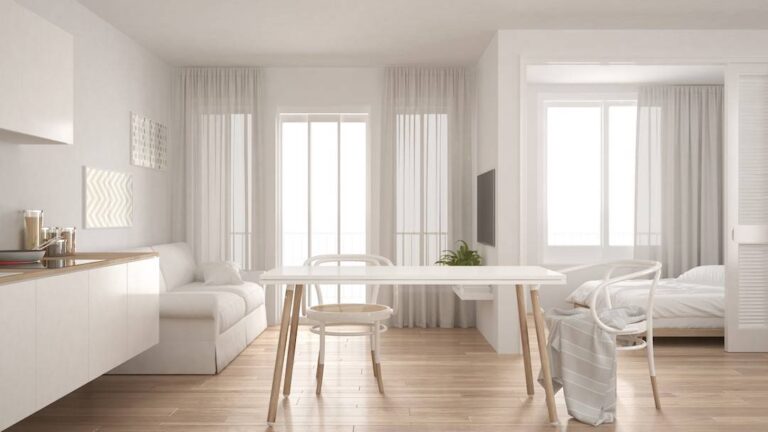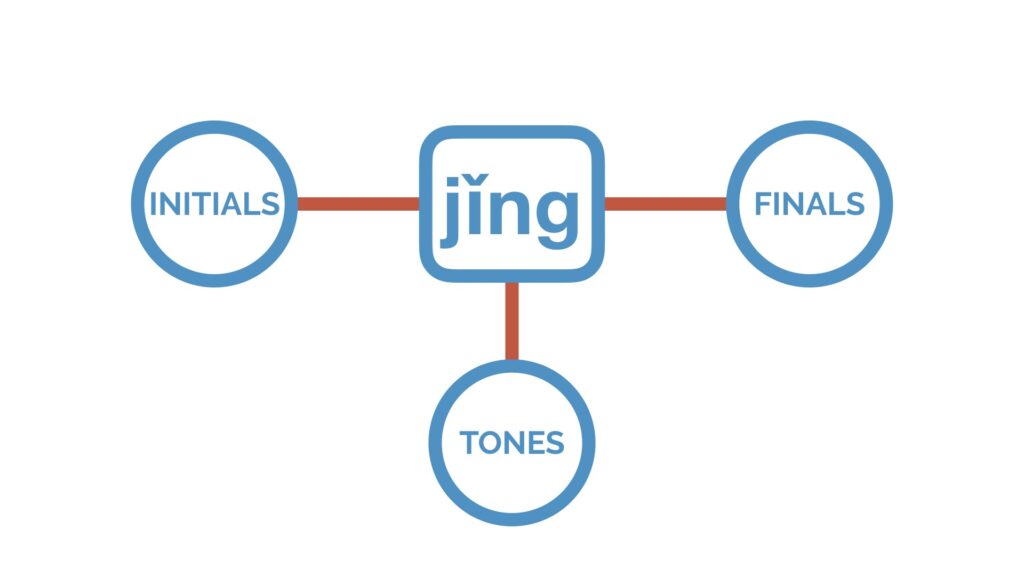The Hanzi Movie Method (Part 3): Using "Sets" to Learn Pinyin Finals

The Hanzi Movie Method is a mnemonic system for learning Chinese characters. It is the most critical subset of our larger curriculum. This is part three of “Pinyin Finals” of a series explaining the Hanzi Movie Method. Click below to navigate the various parts:
Part 1 – Part 2 – Part 3 – Part 4 – Part 5 – Part 6 – Part 7 – New Pinyin Chart
P.S. If you are brand new to the Chinese language, we recommend first checking out our article on Chinese Characters.
NOTE: We based this document on the Hanzi Movie Method Pinyin Chart, which has different categorizations for “Initials” and “Finals” than the original chart. While applying the method does not require an understanding of why we made these changes, if you are curious you can check this out.

The Chinese Memory Palace
We are not the first people to advise using mnemonic visualization to memorize 汉字, but almost all of it focuses exclusively on the meaning and character components. How an individual Chinese character is pronounced is often left by the wayside, and this is a significant problem. It’s not a phonetic language, so without memory techniques, you are forced to once again fall back on rote learning. That sucks.

As we already mentioned in part one of this series, to memorize the various elements we need to know about a character. We simply need to connect real-life concepts to them. By doing this, we can solve a problem that has not yet been solved in the Chinese learning community. How to learn the pronunciation of a character as well as its meaning and appearance at the same time.
Aside from a handful of exceptions, every one of the roughly 400 Chinese syllables is made up of three elements: Initial, Final, and Tone. We link these to people, places (buildings), and rooms within a place respectively.
What makes The Hanzi Movie Method even more unique is its commitment to flexibility. While other modes of Mandarin syllable mnemonics are rigid, the MBM approach follows the advice of the World Memory Champions. We will encourage you to pick actors and sets relevant to your personal lived experience.
Sets & The Chinese Memory Palace – How Does it Work?
The neural networks in your brain that represent the people and places who left the most significant impression upon you are, by definition, the most solid. Consequently, people and places you know well or know a lot about are much more memorable.
The simplest way to understand how sets function within the Hanzi Movie Method is that Sets represent Pinyin Finals. As mentioned above, we re-defined which sounds fall into the category of “Finals” and “Initials,” however it is unnecessary to understand the mechanism behind it to follow the method. All you have to do is assign a “set” to the next 13 finals:
-a, -o, -e, -ai, -ei, -ao, -ou, -an, -ang, -(e)n, -(e)ng, -ong & Ø Null
Advice On Choosing Sets
Below each “Set the Scene” video is a detailed description of how to choose the Set that relates to the individual Pinyin Finals, however here are some types of places you can consider:




- Places you’ve lived
- Schools
- Friend’s Houses
- Restaurants or Shops
- Workplaces
- Hotels
- Gyms or Stadiums
- Auditoriums or Performance Venues
- Any other place you can distinctly remember
The Room Within the Set Represents the Tone
Each Set should have clearly defined rooms or areas. While it is acceptable to choose an entirely outdoor Set, you must be sure that there are at least four clearly defined boundaries between the different sections of the outdoor environment. The four areas will represent the four Mandarin tones.
Technically speaking, you could randomly assign any four rooms to any of the four tones. However, we recommend applying as much consistency as possible across your 13 Sets to mitigate confusion. Here are our recommendations (pictures from Phil’s childhood home):

1st Tone – Outside the Entrance
Regardless of which type of Set you select (school, home, workplace, etc.), they all have entrances, so imagine yourself outside the entrance, and you’ll know that your scene is representative of 1st tone.

2nd Tone – Kitchen or Inside the Entrance
The kitchen is an ideal choice for 2nd Tone because a kitchen has many instantly recognizable characteristics. If you see a stove, sink, refrigerator, etc., you immediately know that the scene is representative of a 2nd Tone 汉字. However, certain types of sets do not have a kitchen, in which case we recommend visualizing your scenes taking place just inside the entrance of the Set.

3rd Tone- Bedroom, Living Room or Any Alternative Room
In the same way that the characteristics of a kitchen are instantly recognizable, so are the components of a bedroom. There’s a bed there for heck’s sake. In some Sets you may have more memories in the Living Room, so that is acceptable as well. Of course, certain types of Sets contain neither a bedroom or a living room. In this scenario, you can assign 3rd Tone to any room that does not conflict with the other tones.

4th Tone – Bathroom or Backyard
Bathrooms have toilets, sinks & showers, and so they are also easy to visualize and directly associate with 4th Tone. The backyard is another option if your emotional memory of a particular back garden is quite strong.
5th Tone – On the Roof
There are very few characters that are only a 5th Tone, but in the rare instances that this does take place, shoot your scene on the roof.
NOTE: We recommend NOT choosing studio apartments as Sets as it is harder to determine which section of the condo represents which Mandarin tone. The borders are just not clear enough.
Remembering the “Epoch” of the Set
Skilled memory athletes encourage taking the time to analyze the “epochs” of your personal history to more easily bring to mind fodder for your mnemonics. So what’s an “epoch?” One of the definitions of the word epoch is “a particular period of time marked by distinctive features, events, etc.” Therefore, If your life were a book, an epoch would be a chapter.
Your Sets are one of the best triggers to the epochs of your life. Imagining yourself standing in your college dorm room, middle school or most hated workplace has the potential to transport you back to that chapter of your life instantly. It doesn’t just have to be about memories in that particular location either; it could just as easily be a reminder of other life events going on during that period. Taking a few moments to let that emotional memory wash over you will naturally give you more fodder for your movies scenes.
Here are Phil’s Sets you can use to get a clearer idea of how this works:
Ø NULL – Childhood Home




Many syllables in The Hanzi Movie Method have no final (Ø Null), but it is still necessary to shoot a scene in a memorable location to take advantage of our brain’s 3D spatial imaging capacity. We highly recommend selecting your Childhood Home to represent the ‘Ø Null’ Final. This final will appear the most, and your childhood home is an ideal choice because of the emotional memory residing there. To be clear, this is not a requirement, but we still think it is the best choice.

Pinyin Final: -a
Set: Fairmount Ave Apartment in Philadelphia – Phil’s first-ever apartment after moving out of his parents’ house.
Link to Chinese: The connection to “-a” is that his roommate was a friend named “Alex.”
Phil’s Epoch: The first apartment after moving out of one’s parents’ house often has memories of excitement and individuation. That year Phil was studying accounting at Temple University, which was a real slog, but on the other hand, he had a great time with his roommate and fellow drummer Alex. Phil’s memory of that epoch was that of a freedom & potential like he’d never seen before, and that excited energy provided excellent fodder for Hanzi Movie Method scenes.

Pinyin Final: -o
Set: Dorm room at Temple University
Link to Chinese: Phil’s roommate was a real “bro” (rhymes with “o”)
Phil’s Epoch: Memories of dorm life tend to leave a lasting emotional impact, and Phil’s experience was no different. Thinking about that time easily brings back memories of a deep excitement associated with not only being independent of one’s family but also being surrounded by a whole group of peers in the same situation.

Pinyin Final: -e
Set: Hatfield Elementary School
Link to Chinese: Elementary starts with “e.”
Phil’s Epoch: All throughout elementary school Phil had extraordinarily good luck in his assigned teachers. All seven of them (Kindergarten – 6th Grade) were admirable people who seemed genuinely passionate about educating young people. As a result, whenever he shot a 汉字 movie scene in Hatfield Elementary School, there was nearly endless fodder for the “scripts.”

Pinyin Final: -ai
Set: Kempinski Hotel in Chongqing
Link to Chinese: The band Phil played in at the Kempinski Chongqing had a guitar player named Marty Vai, which also reminds him of Marty McFly from Back to the Future (the vowel sound in “fly” sounds like “-ai.”
Phil’s Epoch: A brand new experience defined this period for Phil. He was playing drums nightly in the Paulaner Brauhaus restaurant attached to the lobby of the Kempinski Hotel Chongqing. He was also living in the hotel, getting food from the hotel restaurant, and swimming in the hotel pool. This time taught Phil a valuable life lesson because despite being surrounded by luxury, there was often a sense of loneliness as a result of not knowing anyone in Chongqing.

Pinyin Final: -ei
Set: Kempinski Hotel in Chengdu
Link to Chinese: Phil’s bandmates were from Trinidad & Tobago. The vowel sound in “Tobago” is almost identical to the sound of “-ei.”
Phil’s Epoch: Two opposite emotional states for Phil defined this epoch. On the one hand, it was during this time that he fell in love with Chengdu and decided to study Chinese in earnest. On the flip side, he had a very consistent and ultimately unresolvable conflict with one of his bandmates that caused a lot of stress. Remember, the most memorable moments in our lives are not all positive. On the contrary, when something is unpleasant or causes emotional pain, we’re much more likely to remember it so that we can more easily avoid a similar circumstance in the future.

Pinyin Final: -ao
Set: John & Katy’s Apartment
Link to Chinese: John and Katy lived in 朝阳区 Cháoyáng qū, a major district in Beijing. The “-ao” in 朝 cháo serves as the link. Of course, if you’re new to Chinese, you won’t necessarily have this type of connection, but it’s handy for those of you who’ve had experiences in China.
Phil’s Epoch: After playing drums in Beijing for about a year, Phil met a guitar & bass player named John who would become a great friend. During this time, Phil spent a lot of time in John’s apartment practicing original music. John’s wife Katy often made came home at the end of the rehearsal with food or cooked a meal. It was such a warm and welcoming experience for Phil that he never forgot and still keeps in touch with John & Katy to this day. The advantage of this type of set is that it makes you excited to learn a 汉字 that happens to have this Pinyin Final, after all, you get to revisit a place of kindness & love.

Pinyin Final: -ou
Set: Beijing Dongzhimen Apartment
Link to Chinese: The link is in the epoch, as this was a time of great “growth” for Phil. The vowel sound in “grow” or “growth” sounds just like “-ou” in Mandarin.
Phil’s Epoch: This is the first place Phil lived after moving to China. He had never lived abroad before, and it felt as though every day was an adventure. Just outside his door was the famous “Ghost Street” (簋街) and a maze of Beijing’s famous hutongs (胡同). As a result of facing the challenge of getting by in a foreign land without knowing the language (yet), he was forced to grow as a person to rise to the occasion.

Pinyin Final: -an
Set: Sam Ash Music, King of Prussia, PA
Link to Chinese: Manager’s name was “Sandu.”
Phil’s Epoch: Sam Ash Music is a big box musical instrument retailer. Phil worked in the drum department selling percussion equipment, and the store was massive. All the employees were in some way connected to music but working at Sam Ash to pay the bills. This made for quite a motley crew of personalities that certainly didn’t fit the mold of corporate employees. The greatest lesson of this epoch for Phil was how to be a great boss. The general manager named Sandu simultaneously expected the best from the staff while also inspiring loyalty like no one Phil has met since. Every time Phil had a scene taking place in the “-an” set, it was always a piece of cake to come up with ideas.

Pinyin Final: -ang
Set: 19th & Angley St. Apartment
Link to Chinese: “Angley” St. & “-ang.”
Phil’s Epoch: Phil lived in this apartment with three different sets of roommates, all of whom he loved dearly and are still friends to this day. Naturally, many fond memories in that apartment can be applied to mnemonic scenes.

Pinyin Final: -(e)n
Set: Pennfield Middle School
Link to Chinese: The “en” in Pennfield maps to “-(e)n.”
Phil’s Epoch: Unlike elementary school, middle school was defined by puberty & awkwardness for Phil. The students from five different elementary schools all funneled into the middle school, and like many children of that age (12-15), it was challenging to handle socially. Despite the memories of social stress, this was also the time that Phil started to establish himself as a skilled drummer for his age, and so he chose to make 3rd Tone scenes take place in the Band Room or Auditorium.

Pinyin Final: -(e)ng
Set: Kindergarten in Beijing
Link to Chinese: This is where Phil taught English (English->eng) upon arriving in China.
Phil’s Epoch: Like many who come to China, Phil’s first occupation was teaching English. This place reminds Phil of alternating between joy and frustration by the children (ages 4-6). Phil discovered that he admires children’s curiosity, but also felt stressed that he didn’t know how to handle emotional outbursts or conflicts between students very well. These emotions served as great fodder for Phil’s scenes.

Pinyin Final: -ong
Set: Sing Song Music Store
Link to Chinese: Song has “-ong” in it.
Phil’s Epoch: Phil is a drummer and took drum lessons at a store hilariously named “Sing Song Music.” Drumming was great for Phil emotionally during the awkward teenage years of this epoch. It gave him confidence that he could excel at something so long as he practiced every day, and once again he was fortunate to have an excellent teacher.
There is no need to assign all 13 sets at one time. Instead, choose your Sets whenever a “Set the Scene” video comes up in the video course sequence. After you select a set to represent one of the Pinyin Finals, record it in the “browse” function of Anki. A full explanation of how to do this is on this Shared Google Slide.
A Special Case in the Chinese Memory Palace: -(e)n & (e)ng
Note: This section of the document discusses combining Actors (Pinyin Initials) with Sets (Pinyin Finals). If you haven’t read the Actors Google Doc, we recommend reading that first to understand the following few paragraphs.
You’ll notice that the finals -(e)n & -(e)ng have a floating “e.” When a female, fictional or world leader actor combines with one of these sets, the “e” drops in the Pinyin spelling. For the male actors, it does not. Examples:
L – Male Actor + -(e)ng Set = leng (“e” doesn’t drop)
Li – Female Actor + -(e)ng Set = ling (“e” drops)
Lu – Fictional Actor + -(e)n Set = lun (“e” drops. Fictional actors never combine with “-(e)ng”)
Qu – World Leader + -(e)n Set = qun (“e” drops. World Leaders never combine with “(e)ng”)
Choose Your Sets for Pinyin Finals Wisely
There are only 13 sets to choose from, but as illustrated above they can be the gateway to a whole series of emotionally resonant chapters of your life. With that in mind, you’ll likely understand what we mean when we say that The Mandarin Blueprint Method uses the memoir of your life to teach you Chinese. It still takes mental effort to bring to mind your past, but the alternative of rote learning pales in comparison to “a trip down memory lane” when it comes to fun, and hey, you might just learn a bit about yourself in the process.








